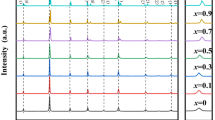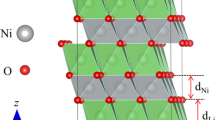Abstract
La2CoMnO6 has attracted intensive research interest because of its prospect for novel technological applications and rich fundamental physics. And, due to the similar radii size as well as small covalent difference (as large as 2) between Co and Mn, cation disorder should be intrinsic within this perovskite. We performed comprehensive first-principles calculations on both La2CoMnO6 (LCMO) and LCMO with CoMn-MnCo antisite defects (AD:LCMO), focusing on the formation of bulk oxygen vacancies, which plays a key role in oxygen ion diffusion process in solid oxide fuel cell (SOFC) electrodes. First, it is found that the covalent states are 2 and +4 for Co and Mn at their regular sites while they are both prone to be +3 in the antisites. The formation energies for oxygen vacancies are predicted to follow the trend Co2+-O-Mn4+ > Co2+-O-Co3+ > Mn3+-O-Mn4+, and the underlying microscopic mechanism is attributed to the more electron delocalization between mixed-covalent transition metals (Co2+-O-Co3+ and Mn3+-O-Mn4+), which is beneficial to diminish the electronic repulsion and help to stabilize the vacancy. Therefore, we could conclude that oxygen ionic conductivity should be enhanced in the compounds with higher degree of cation disorder. Our results indicate that AD:LCMO should be a promising intermediate-temperature solid oxide fuel cell cathode material.

Based on first-principles calculations, we studied ordered LCMO as well as LCMO with CoMn-MnCo antisite defects (AD:LCMO). First, it was found that the covalent states are +2 and +4 for Co and Mn at regular sites while they are both prone to be +3 in the antisites. The formation energies for oxygen vacancies are predicted to follow the trend Co2+-O-Mn4+ > Co2+-O-Co3+ > Mn3+-O-Mn4+, and the underlying microscopic mechanism for this trend is attributed to the more delocalization of the electrons within AD:LCMO due to the mixed-covalent transition-metal pairs.




Similar content being viewed by others
References
Boudghene Stambouli A, Traversa E (2002) Renew Sust Energy Rev 6:433
Sammes M, Smirnova A, Vasylyev O (eds) (2005) Fuel cell technologies: state and perspectives. Springer, Dordrecht
Steele BCH, Heinzel A (2001) Nature 414:345
Yang L, Wang S, Blinn K, Liu M, Cheng Z, Liu M (2009) Science 326:126
M Godickermeier (1996) Mixed ionic electronic conductors for solid oxide fuel cells. PhD Thesis, Swiss Federal Institute of Technology, Zurich, Switzerland
Jacobson AJ (2010) Chem Mater 22:660
Aguadero A, Alonso JA, Escudero MJ, Daza L (2008) Solid State Ionics 179:393
Kobayashi KI, Kimura T, Sawada H, Terakura K, Tokura Y (1998) Nature 395:677
Liu GY, Rao GH, Feng XM, Yang HF, Ouyang ZW, Liu WF, Liang JK (2003) J Phys Condens Matter 15:2053
Liu Q, Dong X, Xiao G, Zhao F, Chen F (2010) Adv Mater 22:5478
Muñoz-García AB, Pavone M, Carter EA (2011) Chem Mater 23:4525
Kim B, Choi HC, Kim BH, Min BI (2010) Phys Rev B 81:224402
Sanchez D, Alonso JA, Garcı′a-Hernandez M, Martı′nez-Lope MJ, Martı′nez JL, Mellergard A (2002) Phys Rev B 65:104426
Navarro J, Nogues J, Munoz JS, Fontcuberta J (2003) Phys Rev B 67:174416
Frontera C, Fontcuberta J (2004) Phys Rev B 69:014406
Kresse G, Furthmueller J (2003) VASP the guide. University of Vienna, Vienna
Dudarev SL, Botton GA, Savrasov SY, Humphreys CJ, Sutton AP (1998) Phys Rev B 57:1505
Anisimov VI, Zaanen J, Andersen OK (1991) Phys Rev B 44:943
Perdew JP, Zunger A (1981) Phys Rev B 23:5048
Perdew JP, Burke K, Ernzerhof M (1996) Phys Rev Lett 77:3865
Blochl P (1994) Phys Rev B 50:17953
Monkhorst HJ, Pack JD (1976) Phys Rev B 13:5188
Bader RFW (1990) Atoms in molecules—a quantum theory. Oxford University Press, New York
Rogado NS, Li J, Sleight AW, Subramanian MA (2005) Adv Mater 17:2225
Bull CL, Gleeson D, Knight KS (2003) J Phys Condens Matter 15:4927
Dass RI, Goodenough JB (2003) Phys Rev B 67:014401
Dass RI, Yan J-Q, Goodenough JB (2003) Phys Rev B 68:064415
Baidya S, Saha-Dasgupta T (2011) Phys Rev B 84:035131
Lv S, Wang Z, Saito M, Ikuhara Y (2013) J Appl Phys 113:203704
Kyomen T, Yamazaki R, Itoh M (2004) Chem Mater 16:179
Lv S, Liu X, Li H, Han L, Wang Z, Meng J (2012) J Comput Chem 33:1433
Ogale AS, Ogale SB, Ramesh R, Venkatesan T (1999) Appl Phys Lett 75:537
Acknowledgments
This work was supported by the National Natural Science Foundation of China under grant Nos. 51002148, 20921002, and 21471002 and Natural Scientific Foundation of Jilin Province 20130101016JC and the Jilin Provincial Science Research Foundation of China (No. 20101549).
Author information
Authors and Affiliations
Corresponding authors
Rights and permissions
About this article
Cite this article
Yuan, N., Liu, X., Meng, F. et al. First-principles study of La2CoMnO6: a promising cathode material for intermediate-temperature solid oxide fuel cells due to intrinsic Co-Mn cation disorder. Ionics 21, 1675–1681 (2015). https://doi.org/10.1007/s11581-014-1320-z
Received:
Revised:
Accepted:
Published:
Issue Date:
DOI: https://doi.org/10.1007/s11581-014-1320-z




